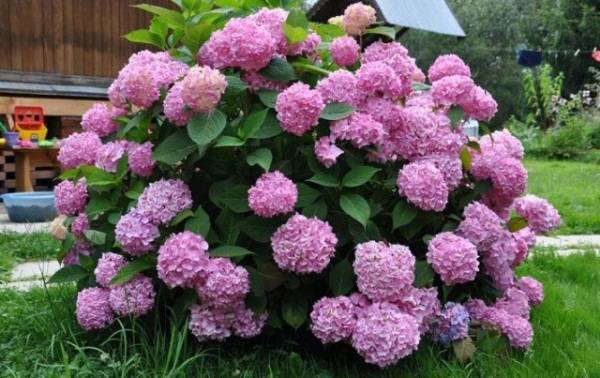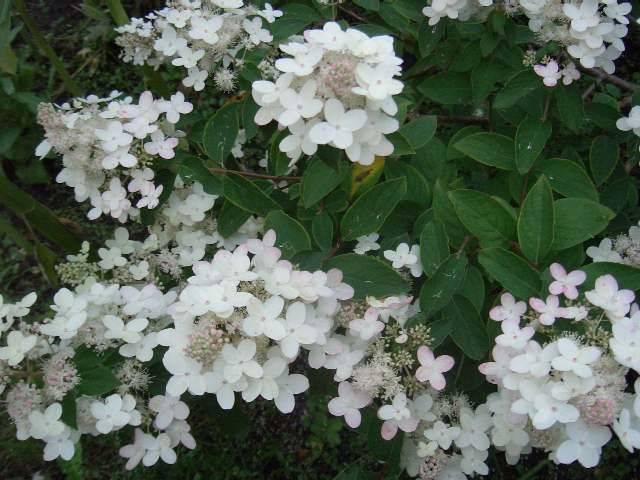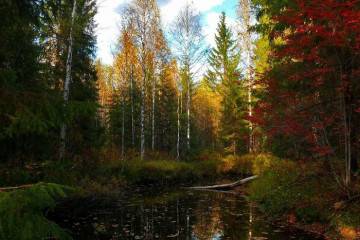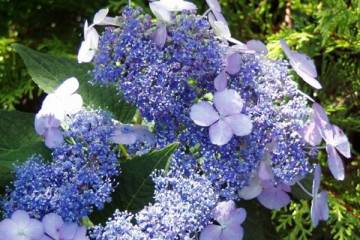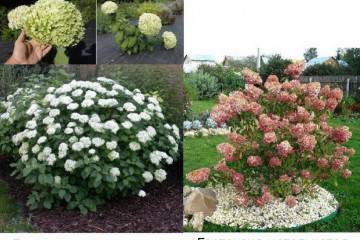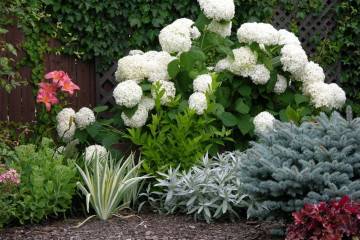Hydrangea white - what are garden hydrangeas
Content:
The area near the house and the garden can be decorated with trees, shrubs and flowers. A beautiful plantation is a white, lilac, purple, yellow hydrangea. The wide color palette allows you to combine it with other plants to create a vibrant hedge. Before planting, you need to know what a white hydrangea looks like, its origin, varieties and rules of care.
Hydrangea white garden spherical
Previously, shrubs could be found in almost every yard. It is unpretentious in comparison with other plants, so both beginners and professional gardeners love it. White globular hydrangea can be grown in the Moscow region, Siberia, the Far East and the Urals.
The origin and appearance of the plant
For the first time, hydrangea was brought to Europe at the end of the 18th century from the island of Mauritius by participants in a round-the-world expedition. The flower got a beautiful name in honor of Princess Hortense, who was the sister of Prince C.G. Nassau-Siegen.
There are two more versions of the origin of the name of the plant - in honor of the beloved woman of the French doctor F. Commerson and translation from Latin, which means "from the garden."
Plant flower descriptions
Most hydrangeas have lilac, pink, blue, red, cream or white flowers that are gathered in panicles or "scutes". Inflorescences can be small (fertile) with seed formation after two weeks of flowering or large (sterile) with ball formation.
Types and varieties
There are several varieties of hydrangeas - treelike, paniculate, large-leaved, oak-leaved.
Tree-like
It is the most common type of shrub due to its cold hardiness and abundant flowering. Hydrangea with a round crown reaches up to 1.5 in height, but under certain conditions it can be 2.5 m. Shoots are slightly lowered, foliage is 6-20 elliptical or ovoid in shape. Sterile white flowers are collected in corymbose inflorescences.
The shrub reproduces by division, layering, cuttings. It is picky about watering and soil, frost-resistant. Can be combined with lilies, clematis and roses. Looks nice as part of a hedge. The best varieties of tree hydrangea are Annabel, Grandiflora, Sterilis and Hayes Starburst.
Paniculata
Hydrangea is a small tree or large shrub with a dense and rounded crown, which reaches a height of 3 m. The leaves are up to 12 cm long, ovoid or oval. Panicles 20 cm long collect flowers inside.
Only at the age of 4-5 years can you see the first flowering of the plant from June to October. It perfectly tolerates urban conditions, but the bush is picky about moisture and soil.
Propagated by cuttings. Due to the long life of the stems and easy shaping, it is ideal for both creating hedges and for planting free-standing trees.Here are the most popular types of garden panicle hydrangeas:
- Grandiflora;
- Brussels Lace;
- Kyushu;
- Limelight;
- Matilda;
- Pinky Winky;
- Pink Diamond;
- Floribunda;
- Unique.
For a small garden, it is better to give preference to the dwarf hydrangea Darts Little Dot.
Features of care during the flowering period
In order for the plant to develop correctly and pass all vegetative cycles on time, a complex of different measures is required. Here are the main ones:
- Regular moistening with settled water or rainwater - 25-30 liters per week, in case of heat it can be watered more often.
- Mulching, loosening and weeding the circle near the rhizome - three times over the summer.
- In the spring, the application of bait with nitrogen, and in the period when it begins to bloom - fertilizers with potassium, every 14 days.
- Annual cuts of branches for the purpose of rejuvenation and formation of the plant.
- The best soil is a mixture of peat, sand and turf in equal proportions.
As preparation for the rest period, it is required to remove the foliage, tie the hydrangea into a bunch, make hilling, and install supports.
Frost resistance
In the open field in the garden, paniculate and tree-like hydrangeas are most often grown. Despite the fact that they are considered cold-resistant, young plants require shelter for the frost period without fail. Over time, shrubs become more resistant to winters, and for 4 years of existence, they can no longer be covered.
Other popular types of garden hydrangeas
In total, there are about 80 varieties of the royal flower that came from Southeast Asia and North America. All types of hydrangeas have their own characteristics and unique characteristics.
Hydrangea purple
Hopcorn Blue is purple or bright lilac in color. Grows in a well-lit area, the variety is frost-resistant. The height of the bush reaches 1 m. The flowering period is July-September.
The Ramars variety is characterized by flowers of different colors - purple, blue, blue and violet. Loves shade, moisture and reaches 80 cm in height.
Hydrangea yellow
The yellow Lamlight variety is very popular. Flowers appear on the plant from mid-summer to September. They change color from greenish yellow to creamy yellow.
The features of the species are fully revealed when landing in partial shade. To obtain yellow flowers with green inserts, it is necessary to remove the hydrangea from direct sunlight.
Hydrangea burgundy
Weems Red is a beautiful shrub up to 2 in height with large openwork flowers that cover it from top to ground. The flowering period begins in early summer when white buds appear, but later they turn deep pink and then take on a burgundy red color.
Hydrangea lilac
The thinker's dream is characterized by large flowers up to 3 cm in diameter, which are collected in inflorescences up to 20 cm in diameter. The original color of the variety is lilac, but new forms can be with the addition of pink or white shades. The shrub blooms in July, but the flowers do not completely fall off.
Hydrangea white-pink
The gourmet Vanilla Fraze is often compared to creamy strawberry ice cream. Shrub up to 2 m high, with heavy inflorescences and small white-pink flowers. Rarely sick, used when creating a hedge. The flowering period is June-September.
Royal hydrangea
The bush variety Royal Flower is distinguished by its stable and strong inflorescences. The plant grows up to 1 m in height with a diameter of 75 cm. At first, the flowers are white, but by the end of the season they take on a pale pink hue. The flowering period falls in mid-summer and early autumn. Loves partial shade, drained and moist soil.
Hydrangea tricolor
Feast is a plant variety with tricolor flowers with bright pink petals, a bluish center, and light green tips. Lush shrubs grow up to nd, 2 m in width and height. You should also pay attention to the Tricolor, this hydrangea is characterized by an unusual color of foliage. A low-growing bush, used for group or single planting, has tricolor leaves.
Low-growing hydrangeas for the garden
Most often, the plant grows up to 3 m with spherical or flat inflorescences about 20 cm in size. There are varieties that are intended for growing in small containers and pots. Low-growing varieties grow up to 1 m in height, and here are the most popular ones:
- Bomshel;
- Pinky Winky;
- Bobo;
- Brucelle Leys;
- Darts Little Dot;
- Last Post.
Large-leaved hydrangea does not tolerate cold, limestone. It grows to a height of 50 cm, and the flowering period falls in mid-summer. The most popular varieties are Changeable, Japanese.
Hydrangeas with small flowers
The Japanese variety Bluebird is a bush with a strong trunk up to 1 m 20 cm high. The crown can grow up to 1.5 m wide. Oval green leaves with jagged edges. The serrated hydrangea has small purple or pink flowers on the inside and with larger ones with a blue tint on the outside.
Large-leaved hydrangea
Chameleon is an ornamental shrub with inflorescences up to 17 cm. Erect shoots reach 1.5 cm. Large-leaved hydrangea has small pink flowers and bright green foliage. The color range varies from red to blue, depending on the acidity of the soil.
An equally popular large-leaved variety is Wackenbarth Castle. The height of the bush reaches 1.2 m, which has large globular inflorescences and blooms from July to October. The petals are pink in color with a smooth transition to the blue center, which undoubtedly looks beautiful in the bouquet. The acidity of the soil affects the color of the leaves. Used in landscape design.
Regardless of whether it is a regular white or ball-shaped pink hydrangea, it remains the queen of the garden. The huge number of species and varieties allows you to combine several plants, create hedges or control their flowering periods. Depending on the variety, the planting will have a certain color range, height and crown diameter. Before buying seedlings, you need to figure out what types of hydrangeas are and how to properly care for them.

